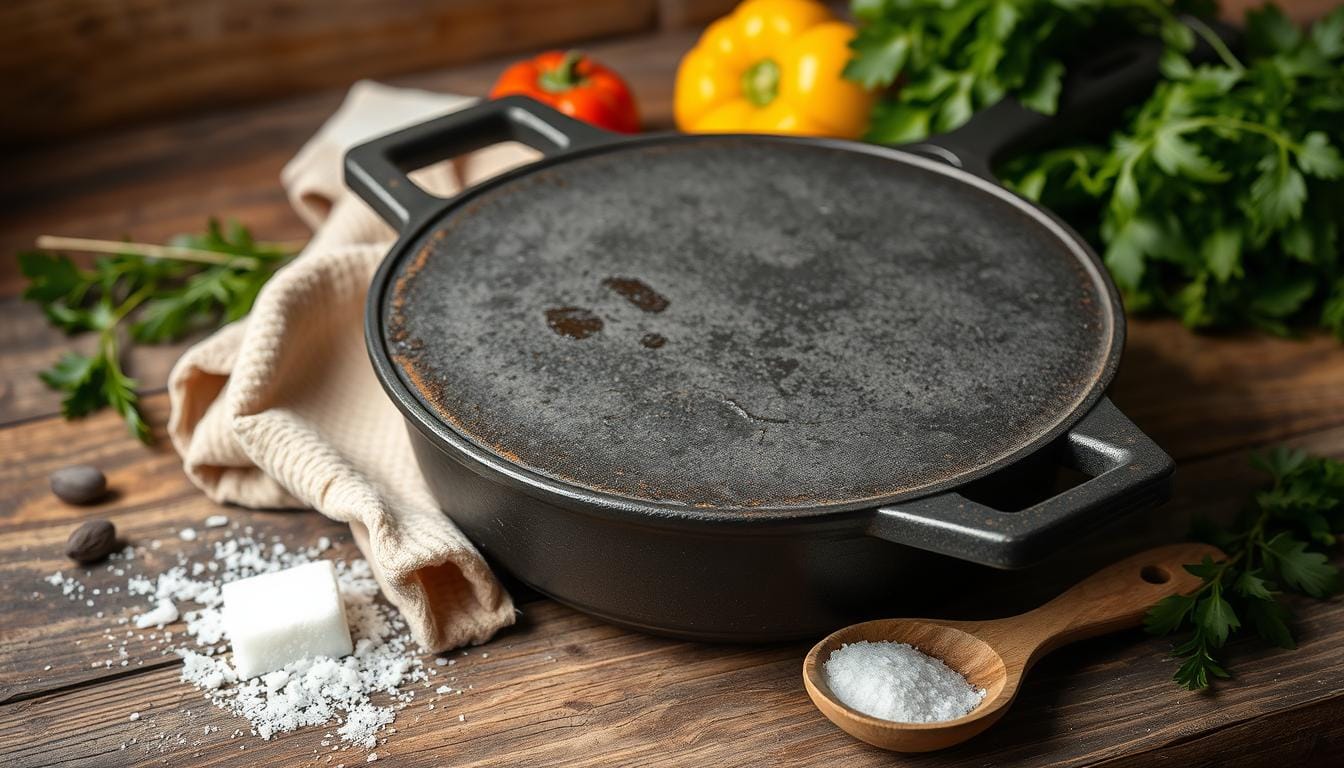I love cooking with cast iron pans. They’re sturdy and versatile, loved by many for generations. But, keeping them clean and seasoned is a delicate task. This guide will show you how to care for your cast iron pan, from daily upkeep to deep cleaning.
Whether you’re new to cast iron or a seasoned pro, this guide has you covered. We’ll dive into the art of caring for your pan. This way, it will stay in great shape for years.
Understanding the Importance of Seasoning
Seasoning is vital for a cast iron pan to work well. It creates a non-stick surface by bonding oil layers to the pan. This prevents rust and makes cooking and cleaning easier.
What is Seasoning?
Seasoning involves applying oil to the pan and baking it at high heat. This makes the oil stick to the metal, creating a non-stick layer. You can season the pan many times to build up layers, making it better with each use.
Benefits of a Well-Seasoned Pan
- Improved non-stick properties: A seasoned pan cooks and cleans easier.
- Rust prevention: The seasoning stops moisture and prevents rust.
- Enhanced cooking performance: As seasoning builds, the pan heats evenly and keeps heat better.
- Durability: With care, a seasoned pan can last for generations.
Keeping your cast iron pan seasoned is key for its long life and best cooking. By following the right steps, you can keep your pan in great shape. Enjoy the benefits of this valuable kitchen tool.
Tools You’ll Need for Cleaning
Keeping your cast iron pan in top shape requires the right tools. You’ll need basic supplies and some extra tools for tough stains. Let’s look at what you should have in your cleaning kit.
Essential Cleaning Supplies
For cleaning your seasoned cast iron pan, you’ll need hot water, a scrub brush, and paper towels. These simple items are enough for everyday cleaning. But, don’t use harsh dish soaps often. They can remove the seasoning from your pan. Instead, use gentle, natural dish soap if needed.
Optional Tools for Tough Stains
- Chainmail Scrubber: This tool is great for getting rid of stuck-on food without harming the seasoning. Its chainmail design is soft yet effective on cast iron.
- Coarse Salt: A bit of coarse salt can help remove tough stains. Just rub it on the pan with a damp cloth or paper towel.
- Lodge Rust Eraser: If your cast iron has rust, this tool can help clean it without losing the seasoning.
While steel wool can fix rusted cast iron, it’s not good for daily cleaning. It can remove the seasoning from your pan.
With the right tools, you can keep your cast iron pan in great shape. It will be ready to cook delicious meals for you over and over again.
Basic Cleaning Steps After Each Use
To keep your cast iron pan in top shape, clean it well after each use. A simple cleaning routine is key. It keeps the pan nonstick and prevents rust.
Immediate Cleanup Guide
Right after cooking, rinse the pan with warm water. Use a stiff-bristled brush to remove food bits. For tough spots, steam the pan and then scrape them off with a spatula.
Using Water and a Scrub Brush
- Don’t use soap, as it can remove the seasoning.
- Dry the pan with a cloth or paper towels, making sure it’s dry.
- While the pan is warm, apply a thin layer of vegetable oil to the inside. This keeps the seasoning and prevents rust.
By following this cleaning routine, you’ll keep your cast iron pan in great shape. It’s essential for daily cast iron care and cleaning after cooking.
How to Handle Stuck-On Food
Dealing with stuck-on food in your cast iron pan requires quick action. It’s crucial to avoid letting the residue bake on. This makes it harder to remove.
Techniques for Soaking
Soaking the pan is a great way to tackle stuck-on food. Fill it with hot water and let it simmer for a few minutes. This loosens the food particles.
Once the water is hot, use a wooden spatula or scrubber to gently scrape off the loosened bits. Be careful not to scrub too hard. This can damage the pan’s seasoning.
Using Baking Soda for Stubborn Spots
For tough spots, make a baking soda paste. Mix a few tablespoons of baking soda with water to form a thick paste. Apply it to the problem areas and let it sit for 10-15 minutes.
Then, scrub gently with a non-abrasive sponge or scrubber. The baking soda’s mild abrasiveness helps remove stuck food without harming the pan’s seasoning.
Remember, avoid prolonged soaking to prevent rust. Always dry and re-season your cast iron pan after cleaning. This keeps it non-stick and extends its life.
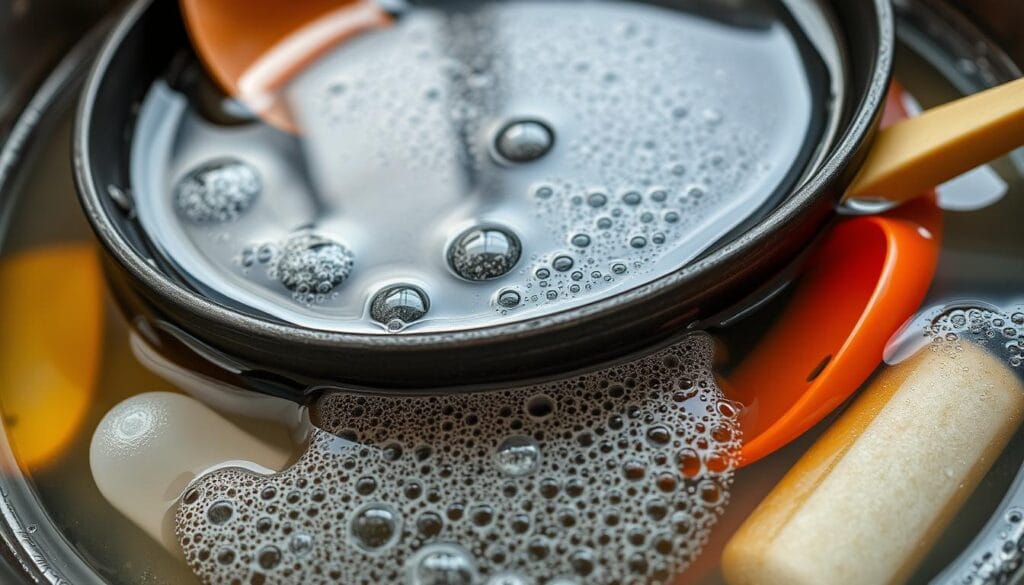
The Role of Salt in Cleaning
Coarse salt is a secret weapon for keeping your cast iron pan in top shape. It’s a natural, abrasive ingredient that gently removes tough food bits. This way, it doesn’t harm the seasoning on your cookware.
Using Coarse Salt as an Abrasive
To clean your cast iron pan with salt, just sprinkle 2 to 3 tablespoons of coarse kosher salt into a warm pan. Then, use a paper towel or a clean, dry cloth to scrub the surface in a circular motion. The salt’s abrasive nature helps remove food bits without damaging the seasoning.
Salt Scrub Techniques
- For extra tough spots, mix coarse salt with a bit of water to make a paste.
- Gently scrub the salt paste onto the affected areas, being careful not to be too aggressive.
- Rinse the pan thoroughly with warm water to remove all salt and food particles.
- Dry the pan immediately over medium-low heat for about 5 minutes to prevent rusting.
- Once dry, apply a thin layer of cast iron seasoning oil to keep it non-stick and protect the seasoning.
Adding this simple salt cleaning method to your cast iron care routine helps remove tough residues. It also keeps the seasoning intact, which is key for a non-stick surface and rich flavor.
Avoiding Common Mistakes
Keeping your cast iron pan in good shape is key. But, it’s easy to make mistakes that can ruin it. From using the wrong cleaning methods to cooking the wrong foods, there are several pitfalls to avoid when caring for your cast iron cookware.
What Not to Use on Your Cast Iron
Harsh detergents, metal scouring pads, and the dishwasher are big no-nos for cleaning cast iron. These can strip away the seasoning that protects your pan and gives it that signature non-stick surface. Instead, use gentle scrubbing with a stiff-bristled brush or a paste of coarse salt and water.
Misconceptions About Cleaning Cast Iron
Contrary to popular belief, you can use a small amount of mild soap occasionally without harming a well-seasoned cast iron pan. The key is to make sure you rinse it thoroughly and dry it completely to prevent rust. Another myth is that you should never soak cast iron in water. While extended soaking is not recommended, a quick rinse is usually fine as long as you dry it promptly.
One of the biggest mistakes people make is cooking highly acidic foods like tomatoes in their cast iron for extended periods. This can strip away the seasoning, so it’s best to limit the time you spend cooking these types of ingredients in your prized skillet.
| Common Cast Iron Care Mistakes | Consequences |
|---|---|
| Using harsh detergents or metal scouring pads | Damages the seasoning and non-stick properties |
| Washing cast iron in the dishwasher | Strips the seasoning and causes rusting |
| Soaking cast iron in water for long periods | Can lead to rust and corrosion |
| Cooking highly acidic foods for extended periods | Weakens the seasoning and can cause iron transfer |
| Neglecting to dry and re-season after cleaning | Invites rust and degrades the non-stick surface |
By avoiding these common mistakes and following proper cleaning and maintenance techniques, you can keep your cast iron pan in top condition and preserve its seasoning for years to come.
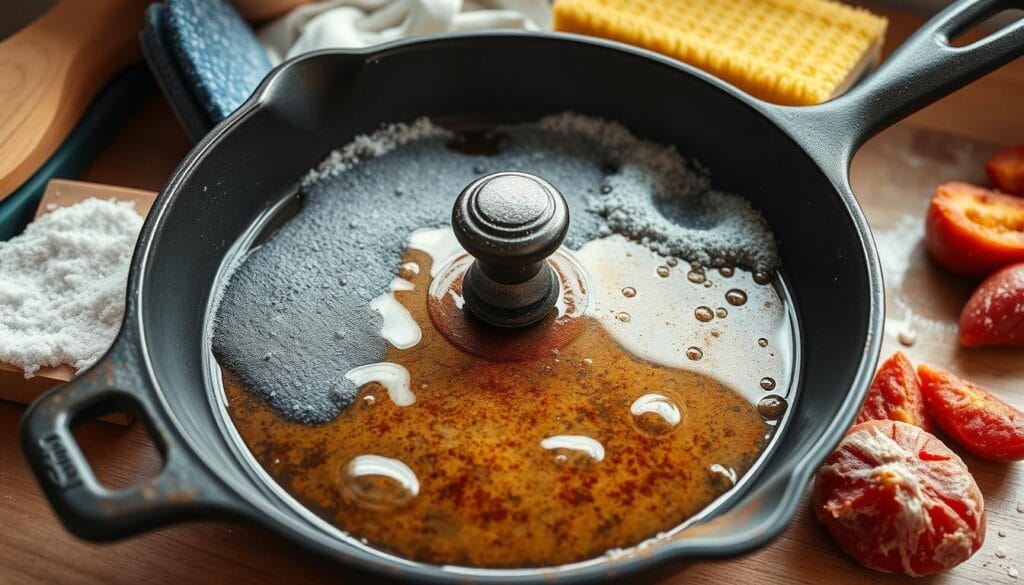
Deep Cleaning Your Cast Iron Pan
Regular care is key to keeping your cast iron pan in great shape. But sometimes, a deep clean is needed. This might be due to heavy buildup, stubborn rust, or wanting to revive an older pan. This deep cleaning can make even the most worn-out pans shine again.
When to Deep Clean
Deep clean your cast iron pan if you see any of these signs:
- Heavily soiled or encrusted surface
- Presence of rust or discoloration
- Inability to properly season the pan
- Difficulty achieving a smooth, non-stick surface
Step-by-Step Deep Cleaning Process
To make your cast iron pan look and cook like new, follow these steps:
- Strip the Seasoning – Begin by removing the old seasoning. You can do this by burying the pan in hot ash overnight or using a self-cleaning oven cycle.
- Address Rust – If rust appears, use steel wool or an electric wire brush to remove it. For tough rust, soak the pan in vinegar and water.
- Wash Thoroughly – After removing seasoning and rust, wash the pan with hot, soapy water. Make sure to remove all residue before drying.
- Dry Completely – Dry the pan completely, either on the stovetop or in a warm oven. Drying it well prevents rust.
- Re-season the Pan – Finally, re-season the pan. Apply a thin layer of oil and bake it in the oven. This creates a new, non-stick surface.
By following this deep cleaning process, you can bring your cast iron pan back to its best. It will then provide years of reliable cooking and delicious meals.
Drying and Storing Your Cast Iron
Proper drying is key to stop preventing rust on your cast iron cookware. After washing, dry the pan with a clean cloth or paper towel. For extra dryness, heat the pan on the stove or in a 200°F oven for 5-10 minutes.
This helps remove any leftover moisture. It also keeps the pan’s seasoning in good shape.
Why Proper Drying is Crucial
Not drying a cast-iron pan right can cause rust. This shows how important it is to dry it well every time. Cast iron can rust easily, and any moisture left can lead to damage.
Best Practices for Storing
After drying, store your cast iron in a dry spot with good air flow. If you stack pans, put paper towels between them to soak up moisture. Don’t store cast iron in humid places, as it can rust.
“Cast-iron skillets are sterilized during the cooking process, reaching 400 degrees Fahrenheit in 4 minutes at medium heat.”
Use shortening, lard, bacon grease, or a neutral oil to rub the cast iron after drying. This helps keep the seasoning and prevents rust.
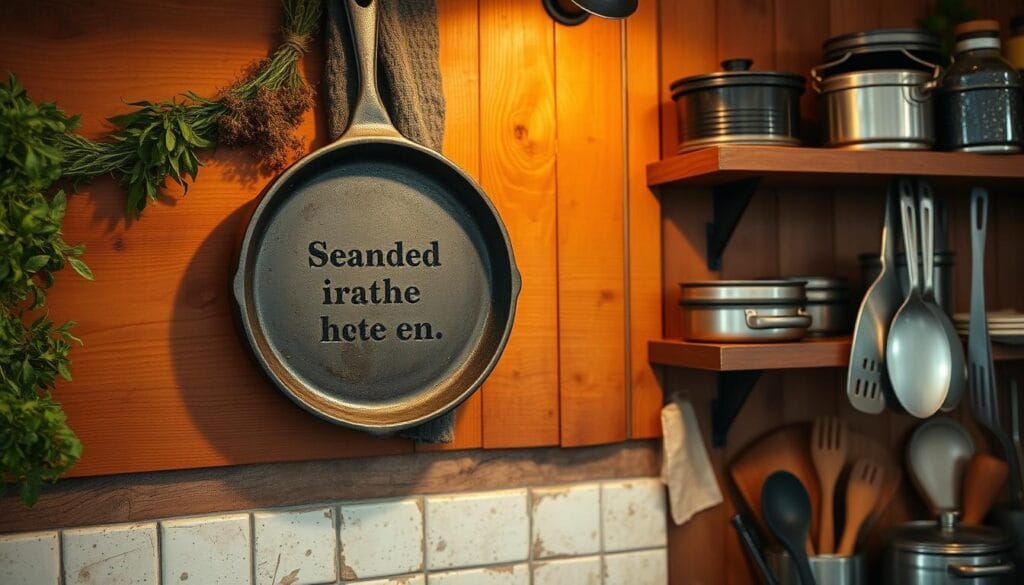
By following these drying and storage tips, your cast iron will stay in great shape. It will be ready to cook delicious meals for many years.
Reapplying Seasoning After Cleaning
Keeping your cast iron pan seasoned is key to its non-stick surface and long life. After cleaning, check if your pan needs re-seasoning. This step rebuilds the protective oil layer, making the pan easy to clean.
How to Assess the Need for Re-seasoning
If your pan looks dull or food sticks, it’s time to re-season. The cast iron seasoning process keeps it non-stick and rust-free. So, it’s vital to keep up with seasoning.
Step-by-Step Re-seasoning Guide
- Spread a thin layer of high-heat oil, like grapeseed, avocado, or canola, over the pan’s surface.
- Wipe off any extra oil, leaving a thin coat.
- Put the pan upside down in a 375°F oven and bake for 30 minutes.
- Let the pan cool in the oven after turning it off.
- Do this 2-4 times for the best seasoning and maintaining non-stick surface.
For oils like canola or sunflower, use a 475°F oven. This ensures the oil bonds well to the cast iron.
“The polymerization process, essential for creating a non-stick surface on cast iron, occurs when oil reaches its smoke point and molecules bond together, forming a smooth coating over the skillet’s pores.”
Regular re-seasoning keeps your cast iron pan in great shape. It ensures it cooks well for many years.
Long-Term Maintenance Tips
Your seasoned cast iron pan can last for generations with the right care. To keep it in top shape, clean and maintain it regularly. Follow these tips to make sure your cast iron stays perfect for years.
Routine Care for Longevity
Regular use and seasoning are key to keeping your cast iron pan in great shape. Cook with it often and use a thin layer of oil to protect the seasoning. Stay away from acidic foods, as they can damage the seasoning.
After each use, clean the pan, dry it well, and apply a thin layer of oil. This keeps the seasoning strong.
Recognizing Signs of Wear
Even with good care, your cast iron pan may show signs of wear over time. Look for uneven color, food sticking, or a dull finish. These signs mean it’s time to re-season the pan.
With regular maintenance, your cast iron will stay non-stick and serve you well for many years.
| Maintenance Task | Frequency |
|---|---|
| Clean and dry after each use | Daily |
| Re-season the pan | Annually or as needed |
| Inspect for signs of wear | Monthly |
Follow these cast iron longevity tips and ongoing maintenance practices. Your seasoned cast iron pan will stay in great condition for years. Regular seasoning upkeep is essential for keeping your cast iron cookware in top shape.
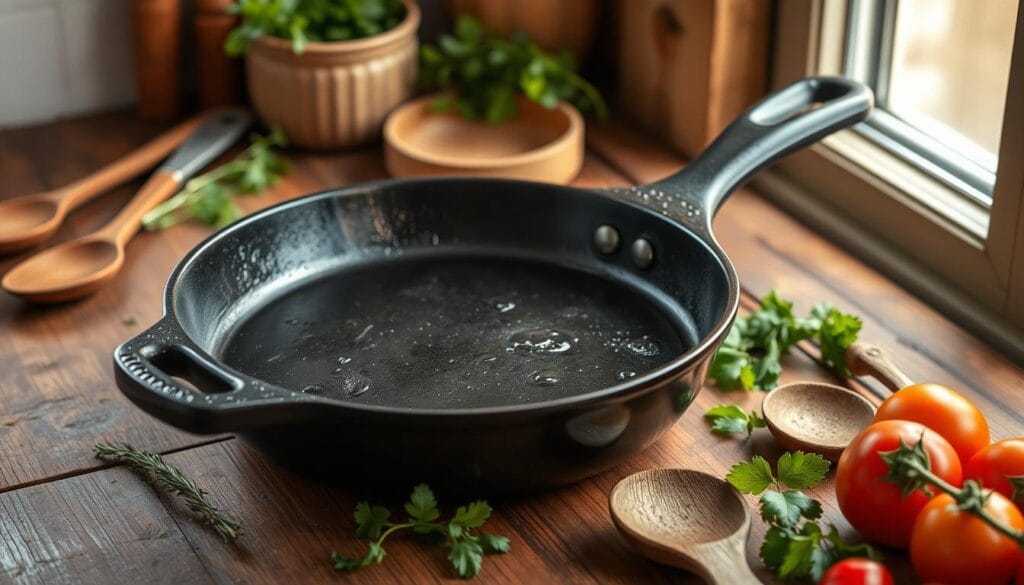
Troubleshooting Common Issues
Keeping your cast iron pan in good shape is key for great cooking and longevity. Even the most careful cooks face some common problems. Let’s look at how to fix these issues and keep your pan looking new.
Rust: Causes and Solutions
Rust is a big problem for cast iron pans. It usually happens when the pan isn’t dried well after washing. To fix rust, use steel wool to scrub off the rust. Then, wash, dry, and re-season the pan right away to stop rust from coming back.
Restoring Non-Stick Properties
Lost the non-stick magic of your cast iron pan? Don’t worry, it can be fixed. Just clean it well and re-season it. Start by cleaning the pan until it’s spotless. Then, apply a thin layer of oil and bake it in a hot oven to make it non-stick again. Do this a few times to build up a strong seasoning.
If food still sticks, it might be time to start over. Strip the pan to metal and season it again. Use steel wool or oven cleaner to remove the old seasoning, then oil and bake it again.
Uneven heating is another issue. It can cause hot spots and uneven cooking. To fix this, preheat your pan slowly on low heat before cooking. This helps the pan heat evenly, making your cooking better.
By solving these common problems, you can keep your cast iron pan in great shape. A well-cared-for pan is a valuable tool in your kitchen, ready for many meals to come.
Conclusion: Keeping Your Cast Iron Pan Pristine
Proper care and maintenance are key to keeping your cast iron pan in top shape for years. Follow essential cleaning steps, dry the pan well after each use, and keep its seasoning up. This way, you’ll keep its non-stick properties and avoid rust.
Recap of Key Cleaning Steps
Cast iron care starts with a regular cleaning routine. Always wipe the pan right after use, avoiding long soaks in water. If food is stuck, use a soft brush and a bit of water. After cleaning, apply a thin layer of oil to protect the seasoning.
Encouragement for Consistent Care
With a bit of effort and consistent care, your cast iron pan will become a kitchen staple. It will grow more versatile and valuable over time. By keeping the seasoning up and preventing rust, you’ll get the most out of your pan.
Enjoy the benefits of superior heat retention, natural non-stick, and a hint of iron in your meals. Caring for your cast iron is rewarding. It will serve you well for generations to come.
FAQ
What is the purpose of seasoning a cast iron pan?
Seasoning makes a cast iron pan non-stick. It involves applying oil and baking it onto the pan. This creates a durable, easy-to-clean surface that gets better with use.
How do I know when my cast iron pan needs to be re-seasoned?
Your pan needs re-seasoning if it looks dull, food sticks, or shows rust. Re-season it when the non-stick layer wears off.
Can I use soap to clean my cast iron pan?
Mild soap is okay for a seasoned pan now and then. But harsh detergents or soaking can damage the seasoning. For daily cleaning, use hot water and a brush without soap.
How do I remove stuck-on food from my cast iron pan?
For tough food, simmer the pan with hot water to loosen it. Then, use a wooden spatula to scrape off the bits. Or, make a paste with baking soda and water, apply it, and scrub gently.
Can I put my cast iron pan in the dishwasher?
No, don’t put your cast iron pan in the dishwasher. The harsh detergents and heat can ruin the seasoning and cause rust. Always wash it by hand.
How do I dry my cast iron pan after cleaning?
Drying your pan well is key to prevent rust. After washing, dry it with a cloth or paper towel. Or, dry it in a 200°F oven for 5-10 minutes.
How often should I re-season my cast iron pan?
Re-season your pan when it loses its non-stick properties. This might be a few times a year, or after deep cleaning or heavy use.
What’s the best way to store my cast iron pan?
Store your pan dry and apply oil to the surface. Keep it in a dry place with air circulation, like a pot rack or cabinet. If stacking, use paper towels to prevent scratches.
How can I restore a rusty cast iron pan?
To fix a rusty pan, scrub off the rust with steel wool or an electric brush. Then, wash, dry, and re-season it with oil and oven baking.

